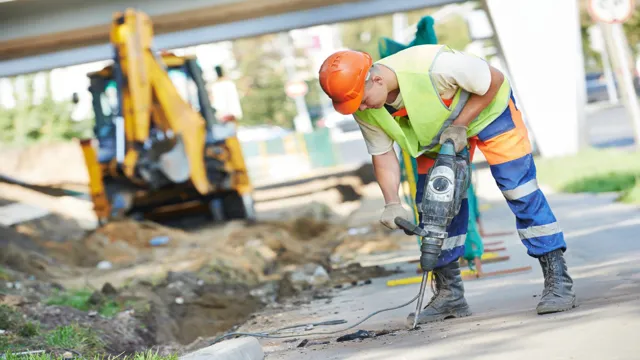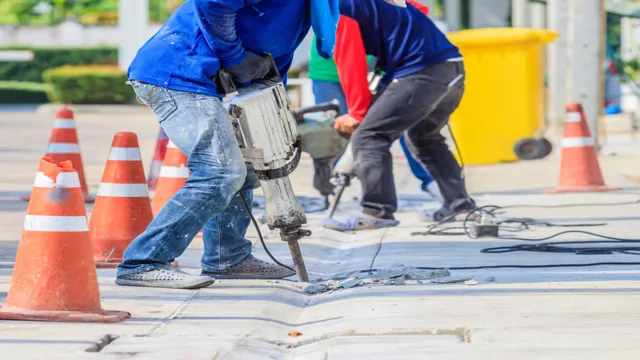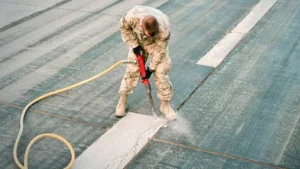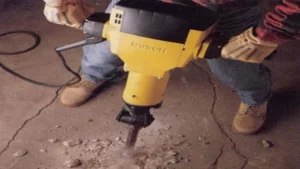Have you ever seen someone use a jackhammer and wondered if it’s as easy as it looks? Well, brace yourself because using a jackhammer may look effortless, but it’s a bit more complicated than that. Jackhammers are powerful tools that can get the job done quickly, but they also pose a considerable safety risk if not handled correctly. Therefore, it’s of utmost importance to learn how to operate one safely.
In this blog post, we will guide you through the safety measures and steps required to operate a jackhammer and give you a handy guide on using a jackhammer safely. So, if you want to know everything about using a jackhammer safely, stick around and read on!
Understanding the Equipment
If you want to learn how to use a jackhammer, you must first understand the equipment. A jackhammer is a powerful tool that is designed to break up concrete and other solid materials with ease. It is typically powered by electricity or compressed air and comes with a variety of attachments that can be used for different jobs.
To use a jackhammer, you will need to secure it firmly in place and adjust the speed and power to suit the task at hand. It is also important to wear protective gear, such as earplugs and safety goggles, to prevent injury. Learning how to use a jackhammer requires practice and patience, but with a bit of effort, you can become an expert in no time.
So, if you need to break up concrete for a home renovation project or construction work, a jackhammer is the perfect tool for the job!
Types of Jackhammers
When it comes to jackhammers, there are different types of equipment available for a wide range of applications. The most common types of jackhammers are electric, pneumatic, and hydraulic, each with different features and advantages. Electric jackhammers are perfect for small to medium-sized projects, as they are easy to operate, lightweight, and don’t require fuel or oil.
Pneumatic jackhammers, on the other hand, are ideal for heavy-duty work, as they provide more power and torque. They are also more fuel-efficient and can withstand high temperatures, making them perfect for long working hours. Hydraulic jackhammers are known for their power, durability, and versatility, as they can easily attach to various machines and equipment for a range of tasks.
Understanding the different types of jackhammers available can help you choose the right equipment for your specific needs and ensure that you get the job done quickly and efficiently.

Components of Jackhammer
If you’re in the construction industry, you’ve probably encountered a jackhammer at some point. But what makes up this powerful tool? The main components of a jackhammer are the motor, the hammer, and the chisel. The motor is responsible for powering the hammer, which hits the chisel repeatedly to break up concrete or other materials.
The chisel is the part that actually makes contact with the material and breaks it up. To operate the jackhammer, the user typically holds onto the handle, which is connected to the motor, and positions the chisel in the desired location. Understanding each component of the jackhammer is essential to operating and maintaining it properly, which ensures it remains an effective tool on job sites.
So next time you use a jackhammer, remember the combination of motor, hammer, and chisel that make it all possible.
Preparing for Use
Using a jackhammer can be intimidating, but with the right preparation, it can be a breeze. The first step before even picking up the jackhammer is to make sure you have the proper safety equipment. This includes earplugs or earmuffs, safety glasses or a face shield, and heavy-duty gloves.
Once you have your safety gear ready, you can move on to setting up your work area. Make sure the area is clear of people and debris, and identify any potential hazards like underground utilities that may need to be marked before beginning work. It’s also helpful to have a clear plan for the work you will be doing, so you can efficiently and effectively use the jackhammer.
Lastly, test your jackhammer before beginning work to ensure it’s functioning properly. By taking these steps, you can be confident and safe when using a jackhammer.
Checking the Workplace
Checking the workplace before starting any work is crucial to ensure everyone’s safety. The first step is to organize the workspace and ensure there are no hazardous objects that could cause an accident. Start by clearing all the unnecessary clutter that could cause tripping.
Check the floor for any cracks that could cause injuries and fix them before starting. Organize the working area remove anything that could cause a fire, and ensure that all the electrical equipment is working appropriately. The next step is to check if there is proper ventilation and lighting in the area.
Clean the workspace and ensure all the safety equipment is readily available and in good condition. By taking these precautions and checking the workplace before use, you can ensure that yourself and your co-workers work in a safe environment without the risk of injury.
Preparing the Jackhammer
Preparing the jackhammer for use is an important step to ensure that the tool functions properly and safely. Before starting any work, it’s essential to check the jackhammer’s components, including the power cord, motor housing, and chisel. Make sure the power cord is in good condition, with no nicks or cuts.
Check the motor housing for any signs of damage or wear, and inspect the chisel for any cracks or chips. Next, connect the power cord to a grounded electrical outlet and turn on the jackhammer to test the trigger function. If everything looks good, attach the chisel to the jackhammer and adjust the depth gauge to the desired level.
Always wear appropriate personal protective equipment (PPE) like earplugs, gloves, and safety glasses before starting any work. By taking these steps, you can be sure your jackhammer is prepared for safe and efficient use.
Using the Jackhammer
If you’re planning on using a jackhammer, it’s important to know the correct technique to ensure your safety and the effectiveness of the tool. First, make sure you’re wearing protective gear such as gloves, goggles, earplugs, and a hard hat. Before turning on the jackhammer, make sure the plug is securely connected to the power source.
Then hold the jackhammer with both hands, and position it at a 45-degree angle towards the surface you’re demolishing. Let the weight of the tool do the work and apply gentle pressure to the trigger to start breaking up the surface. Move the jackhammer back and forth in a sweeping motion to cover a larger area, and never use it in a straight up-and-down motion.
Take frequent breaks and switch hands to prevent fatigue and strain. Remember to always prioritize your safety and follow all instructions and guidelines for using a jackhammer.
Positioning the Jackhammer
Positioning the Jackhammer for optimal use is crucial to ensuring a safe and efficient project. First, it’s essential to check the ground conditions to confirm the position allows for a stable base. Ideally, the jackhammer should be placed on a flat surface where it won’t slip or move during operation, as this can be dangerous.
Once a suitable spot has been chosen, the operator should position themselves behind the tool and hold it firmly with both hands. The dominant hand should be on the back handle while the other hand should grip the front handle. This posture will ensure that the operator can control the jackhammer’s movements better.
By placing the jackhammer in a stable position, the operator can reduce the risk of injuries and damage to surrounding structures.
Striking Techniques
The Jackhammer is a powerful and effective striking technique that can be used in various martial arts, including boxing, kickboxing, and MMA. This technique involves a fast and forceful downward strike with the fist, similar to the motion of a jackhammer. To execute the Jackhammer properly, start with a good stance, aim for the target, and drive your fist down with a snapping motion.
The key to a successful Jackhammer is speed, accuracy, and power. This striking technique can be an effective way to knock out your opponent or break their guard. However, it should be used with caution and only in self-defense or controlled sparring sessions.
With proper training and practice, the Jackhammer can become a reliable weapon in your arsenal.
Maintaining and Storing the Jackhammer
If you’re wondering how to use a jackhammer, it’s important to also know how to maintain and store it properly for future use. One key aspect of maintenance is keeping the jackhammer clean after each use. You can do this by wiping it down with a damp cloth and drying it thoroughly.
It’s also important to pay attention to any signs of wear and tear on the jackhammer, such as cracks in the housing or damaged parts. If you notice any issues, stop using the jackhammer immediately and have it repaired or replaced by a professional. When it comes to storing the jackhammer, make sure to keep it in a dry area away from any moisture or harsh elements.
You can also store it in a case or cover to protect it from dust and debris. With proper maintenance and storage, your jackhammer will be ready to use for years to come.
Cleaning the Equipment
Maintaining and storing a jackhammer properly can save time and money in the long run. One important aspect of maintenance is cleaning the equipment after every use. To do this, first, unplug and disassemble the jackhammer.
Use a wire brush to remove any dirt or debris from the parts and then wipe them down with a dry cloth. Any stuck-on debris can be removed using a damp cloth or a mild detergent solution. Once the equipment is cleaned, inspect it for any damage or wear and tear.
If any parts are damaged or missing, it is important to repair or replace them before the next use. After the inspection, reassemble the jackhammer and store it in a dry and secure place. Keeping the jackhammer in good condition will extend its lifespan and ensure it is ready to use when needed.
Regular Maintenance and Repairs
Regular maintenance and repairs are essential to keep your jackhammer running smoothly and to extend its lifespan. When it comes to maintaining and storing your jackhammer, there are a few things to keep in mind. Firstly, always clean the jackhammer after every use to ensure that there is no dirt or debris left behind that could damage the tool over time.
This can be done by wiping it down with a cloth, using compressed air to blow out any dust or debris from the air vents, and removing any lingering dirt or grime from the bits and chisels. Secondly, store your jackhammer in a dry, secure location that is free from moisture and extreme temperatures. If you do need to transport the tool, make sure it is properly secured in a padded case or box to prevent damage during transit.
By following these simple steps, you can ensure that your jackhammer stays in top condition and is always ready for your next project.
Conclusion
Congratulations! You now know how to operate a jackhammer like a pro. Remember to dress appropriately, control your breathing, and make sure you have enough power to tackle the task at hand. And most importantly, don’t forget to put on your safety goggles, because when it comes to using a jackhammer, you don’t want to be caught with your eyes closed!”
FAQs
What is a jackhammer and how does it work?
A jackhammer is a handheld tool that uses compressed air or electricity to break up concrete or rock. It works by repeatedly striking the surface with a hammer-like tool called a chisel or point.
What safety precautions should I take before using a jackhammer?
Before using a jackhammer, you should wear protective gear including safety goggles, gloves, earplugs, and a dust mask. You should also ensure that the work area is clear of people and other hazards, and that the jackhammer is properly maintained and fueled.
How do I select the right chisel for my jackhammer?
The right chisel for your jackhammer depends on the type of material you are breaking up. A pointed chisel is best for breaking through concrete or rock, while a flat chisel is better for removing asphalt or tile. A spade chisel is useful for digging or cutting through soil.
Can I use a jackhammer to dig a hole?
Yes, a jackhammer can be used to dig a hole in soil or other soft materials. However, it may not be the most efficient tool for this task, and you may need to switch between different chisels based on the type of soil or depth of the hole.
What maintenance is required for a jackhammer?
Regular maintenance is important to keep your jackhammer functioning properly and extend its lifespan. This includes checking the air filter and spark plug (if using a gas-powered model), lubricating the chisel and other moving parts, and inspecting for any cracks or damage.
Can a novice operate a jackhammer safely?
It is possible for a novice to operate a jackhammer safely, but it is important to receive proper training first. This may include learning about the tool’s features and operating procedures, as well as safety guidelines and best practices for different situations.
What alternatives are there to using a jackhammer?
Depending on the task at hand, there may be alternative tools or methods that are safer and more efficient than a jackhammer. For example, you may be able to use a demolition saw, hydraulic breaker, or digging tool instead. Consulting with a professional or expert can help you determine the best approach for your specific job.






